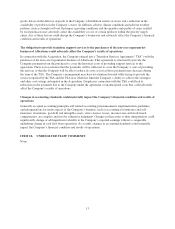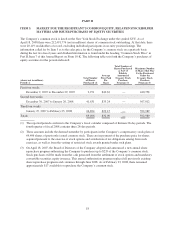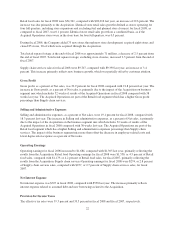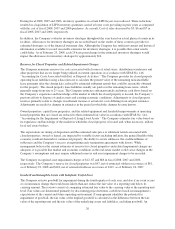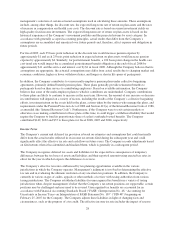Albertsons 2008 Annual Report Download - page 26
Download and view the complete annual report
Please find page 26 of the 2008 Albertsons annual report below. You can navigate through the pages in the report by either clicking on the pages listed below, or by using the keyword search tool below to find specific information within the annual report.ITEM 6. SELECTED FINANCIAL DATA
The information called for by Item 6 is found within the Five Year Financial and Operating Summary on
pages F-2 – F-3.
ITEM 7. MANAGEMENT’S DISCUSSION AND ANALYSIS OF FINANCIAL CONDITION AND
RESULTS OF OPERATIONS
OVERVIEW
SUPERVALU is one of the largest companies in the United States grocery channel. The Company operates in
two segments of the grocery industry, Retail food stores and Supply chain services, which includes wholesale
distribution services and other support services to retailers. At February 23, 2008, the Company conducted its
retail operations through a total of 2,474 stores of which 873 are licensed locations. Principal formats include
combination stores (defined as food and pharmacy), food stores and limited assortment food stores. As of
February 23, 2008, the Company’s Supply chain services network spans 49 states and the Company serves as
primary grocery supplier to approximately 2,200 stores, in addition to the Company’s own stores, as well as
serving as secondary grocery supplier to approximately 500 stores.
The Albertsons Acquisition
On June 2, 2006 (the “Acquisition Date”), the Company acquired New Albertson’s, Inc. (“New Albertsons”) for
a purchase price of approximately $11,370, net of approximately $4,911 of cash for the purchase of the
standalone drug store business by CVS Corporation and the purchase of the non-core supermarket business by an
investment group led by Cerberus Capital Management, L.P. New Albertsons consisted of the core supermarket
businesses (the “Acquired Operations”) formerly owned by Albertson’s, Inc. (“Albertsons”) operating
approximately 1,125 stores under the banners of Acme Markets, Bristol Farms, Jewel-Osco, Shaw’s
Supermarkets, Star Markets, the Albertsons banner in the Intermountain, Northwest and Southern California
regions, the related in-store pharmacies under the Osco and Sav-on banners, 10 distribution centers and certain
regional and corporate offices (the “Acquisition”).
The consideration paid by the Company consisted of approximately $2,661 in cash, $2,251 of SUPERVALU
common stock, $6,123 of debt assumed and approximately $335 related to cash settlement and assumption of
restricted stock unit and stock option awards and direct costs of the Acquisition.
The Acquisition greatly increased the size of the Company. The Acquisition has also significantly changed the
mix of the Company’s segment revenues and operating results for fiscal 2008, compared to fiscal 2007 and 2006.
In fiscal 2008, 78.0 percent of the Company’s Net sales and 92.0 percent of the Company’s Operating earnings
came from the Company’s Retail food segment, compared to 74.9 percent and 90.3 percent, respectively, in fiscal
2007, and 53.5 percent and 61.8 percent, respectively, in fiscal 2006. Fiscal 2008 includes 52 weeks of operating
results of the Acquired Operations compared to 38 weeks for fiscal 2007.
The Industry and the Economic Environment
The retail grocery industry can be characterized as one of continued consolidation and rationalization, with the
Acquisition being one of the largest acquisitions in the history of the industry. Grocery retailers also continue to
compete against an increasing number of competitive formats that are adding square footage devoted to food and
non-food products, such as supercenters, membership warehouse clubs, mass merchandisers, dollar stores, drug
stores and other alternate formats.
The grocery industry is also affected by the general economic environment and its impact on consumer spending
behavior. The Company would characterize fiscal 2008 as a year with lower economic growth, continued high
fuel prices, higher product cost inflation and reduced consumer confidence. In fiscal 2009, the Company expects
consumer spending will continue to be pressured by inflation and the economy.
20





